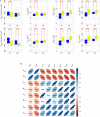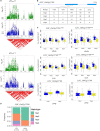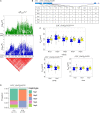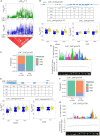Genetic Bases of the Stomata-Related Traits Revealed by a Genome-Wide Association Analysis in Rice (Oryza sativa L.)
- PMID: 32582301
- PMCID: PMC7296080
- DOI: 10.3389/fgene.2020.00611
Genetic Bases of the Stomata-Related Traits Revealed by a Genome-Wide Association Analysis in Rice (Oryza sativa L.)
Abstract
Stomatal density (D) and size (S) are an important adaptive mechanism for abiotic stress tolerance and photosynthesis capacity in rice. However, the genetic base of rice stomata-related traits still remains unclear. We identified quantitative trait loci (QTLs) associated with D and S on abaxial and adaxial leaf surfaces using genome-wide association analysis with 451 diverse accessions in two environments. D and S showed significant differences between indica (xian) and japonica (geng) accessions and significantly negative phenotypic correlations. A total of 64 QTLs influencing eight stomata-related traits were identified using 2,936,762 high-quality single nucleotide polymorphism markers. Twelve QTLs were consistently detected for the same traits in nine chromosomal regions in both environments. In addition, 12 QTL clusters were simultaneously detected for the same stomata-related traits on abaxial and adaxial leaf surfaces in the same environment, probably explaining the genetic bases of significant correlations of the stomata-related traits. We screened 64 candidate genes for the nine consistent QTL regions using haplotype analysis. Among them, LOC_Os01g66120 for qD ada 1, OsSPCH2 (LOC_Os02g15760) for qD ada 2.1 and qD aba 2.1, LOC_Os02g34320 for qS ada 2.2, OsFLP (LOC_Os07g43420) or LOC_Os07g43530 for qS aba 7.1, and LOC_Os07g41200 for qW ada 7 and qW aba 7 were considered as the most likely candidate genes based on functional annotations. The results systematically dissected the genetic base of stomata-related traits and provide useful information for improving rice yield potential via increasing abiotic stress tolerance and photosynthesis capacity under stressed and non-stressed conditions through deploying the favorable alleles underlying stomata-related traits by marker-assisted selection.
Keywords: QTL; candidate gene; genome-wide association study; stomatal density; stomatal size.
Copyright © 2020 Chen, Zhao, Zhai, Shao, Jiang, Shen, Chen, Wang, Wang and Xu.
Figures







References
-
- Bergmann D. C., Sack F. D. (2007). Stomatal development. Annu. Rev. Plant Biol. 58 163–181. - PubMed
LinkOut - more resources
Full Text Sources
Research Materials

